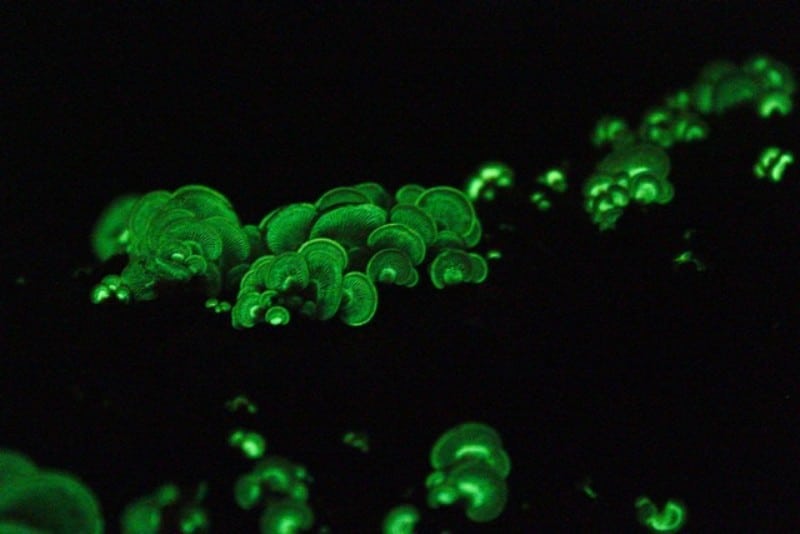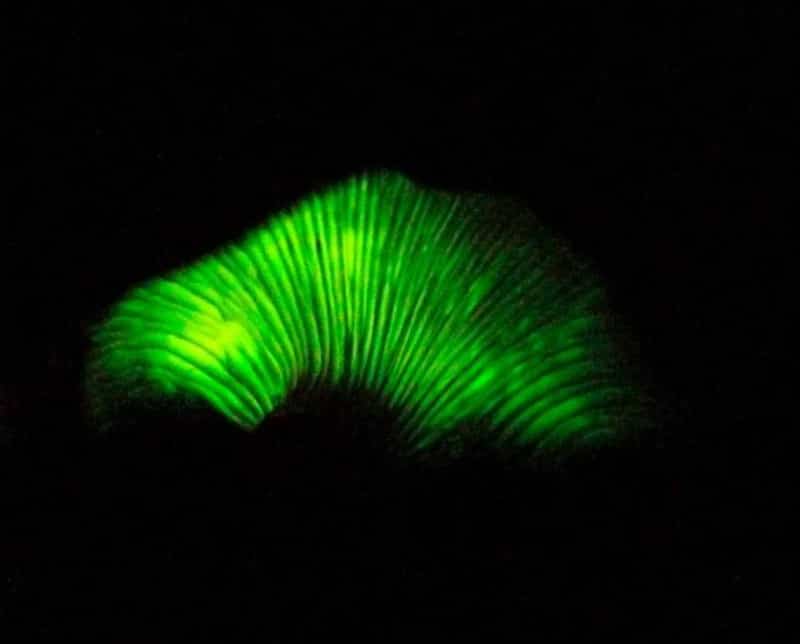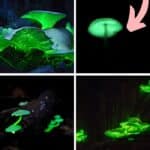Have you ever walked through a forest at night and noticed a soft, eerie green glow emanating from the undergrowth? You might have brushed it off as a trick of the light or an overactive imagination. But what you’ve actually stumbled upon is a fascinating natural phenomenon known as bioluminescence in fungi — mushrooms glow in the dark! This is a trait shared by only a tiny fraction of the over 100,000 known species of fungi.
Mushrooms are fascinating organisms that come in various shapes, sizes, and colors. And some mushrooms have the remarkable ability to glow in the dark. This natural phenomenon, known as bioluminescence, has puzzled scientists and nature enthusiasts for centuries. In this article, we will explore the intriguing world of glowing mushrooms and the reasons behind their luminous display.

Jump to:
- Decoding the Glow: The Science Behind Bioluminescence
- The Mystery of Mushroom Bioluminescence: Why Do Mushrooms Glow In The Dark?
- The Role of Insects in Mushroom Reproduction
- The Control of Mushroom Glow
- The Glowing Marvel
- The Significance of Mushroom Bioluminescence
- The Beauty and Diversity of Glowing Mushrooms
- Exploring the Mechanisms Behind Mushroom Bioluminescence
- The Future of Mushroom Bioluminescence Research
- Common Questions About Glow In The Dark Mushrooms
Decoding the Glow: The Science Behind Bioluminescence
Bioluminescence, simply put, is light produced by a series of chemical reactions within a living organism. It’s not unique to fungi – a variety of organisms, including fireflies, jellyfish, and certain bacteria, also share this captivating characteristic.
In the case of fungi, light is produced when an enzyme interacts with a light-emitting compound with the assistance of additional enzymes, water, and oxygen. The resulting light-emitting molecules are called luciferins, and the enzymes interacting with them are luciferases. The compound produced by fungi that causes them to glow is called oxyluciferin.
According to scientific findings, all 112 (more or less) known bioluminescent mushroom species utilize the same family of fungal luciferins and luciferases.


The Mystery of Mushroom Bioluminescence: Why Do Mushrooms Glow In The Dark?
Even when we understand the how there is still the question of why. What purpose does the glowing provide to the fungi? Even Aristotle, the ancient Greek philosopher, pondered over the reason behind this enigmatic phenomenon. Over time, various theories have been proposed, ranging from it being a metabolic byproduct to a mechanism to attract insects. However, recent research has shed new light on the subject, providing us with a better understanding of why mushrooms glow.


The Role of Insects in Mushroom Reproduction
One of the prevailing theories regarding mushroom bioluminescence is that it serves as a means to attract insects. These insects, including beetles, flies, wasps, and ants, are essential in the reproductive cycle of mushrooms. By landing on the glowing mushrooms, these insects inadvertently carry the mushroom’s spores to new locations, aiding in their dispersal. This symbiotic relationship between mushrooms and insects highlights the intricate web of interactions that exist in the natural world.


The Control of Mushroom Glow
While some mushrooms glow consistently, others exhibit a distinct pattern of bioluminescence. Researchers have discovered that the glow of certain mushrooms is regulated by their internal circadian clock.
Organisms like plants, animals, and fungi generally contain an internal ‘circadian’ clock that attempts to keep up with a 24-hour cycle. For instance, our human sleep-wake pattern, which follows day and night (24 hours total), is a circadian rhythm. When we are exposed to bright white light at night, though, our feeling of sleepiness can be postponed. This implies that if you stay up late looking at the illuminated screen of your computer, you will likely “naturally” want to go to bed later and wake up later the next day.
Just like our own sleep-wake cycle, these mushrooms have an internal biological rhythm that controls when they emit light. The fact that this bioluminescence is timed and regulated by a circadian clock suggests that it isn’t a mere byproduct of metabolism but, instead, an adaptive function that aids in the survival and propagation of the species. So, why do the mushrooms glow?

The Glowing Marvel
The mushroom species Neonothopanus gardneri was chosen to test the circadian rhythm hypothesis because it gives off the brightest light out of all the known bioluminescent fungi. Found in the lush forests of Brazil, these mushrooms emit a vibrant green glow that stands out against the darkness of the night. N. gardneri, also known as “flor de coco” or coconut flower, grows at the base of young babassu palms and is a spectacular sight.
Scientists conducted a series of experiments to unravel the secrets of N. gardneri’s bioluminescence. They created artificial mushrooms using acrylic resin, mimicking the appearance of real mushrooms found in the forest. Some of these fake mushrooms were fitted with green LED lights to replicate the natural glow. Sticky traps were then placed around these artificial fungi to observe the insects’ response. Other fake mushrooms were left entirely dark, so the only difference between the sets was the LED lights.
The results of the experiments were fascinating. The sticky traps attached to the lit-up artificial mushrooms captured a significantly higher number of flies, ants, beetles, and other insects than the traps on the dark artificial mushrooms. This observation strongly suggests that the glowing mushrooms indeed serve as a beacon to attract insects.
By synchronizing their glow with the nighttime, mushrooms maximized their visibility to nocturnal insects, ensuring efficient spore dispersal. Insects would literally run into the fungi, getting spores on them in the process, and when they buzzed away, they took the spores with them. For a stationary mushroom species without wings or legs, this vastly widened the spread of their spores.

The Significance of Mushroom Bioluminescence
Understanding the role of bioluminescence in mushrooms is not merely a scientific curiosity but has broader ecological implications. Mushrooms, such as N. gardneri, play a vital role in forest ecosystems. All known bioluminescent species are white rot fungi. They assist in the decomposition process, breaking down organic matter and recycling nutrients. Without mushrooms, the carbon cycle would be disrupted, potentially impacting life on Earth itself.

Fun Fact: Bioluminescence developed independently among plants, animals, and fungi approximately 94 times
The Beauty and Diversity of Glowing Mushrooms
While N. gardneri is a striking example of a bioluminescent mushroom, it is just one of many species that possess this unique ability. Researchers have identified around 112 species of mushrooms that exhibit bioluminescence. Some are bioluminescent in their fruiting bodies, the above-ground part we see. Others are bioluminescent in their mycelium or sclerotia tissues, the parts that are below ground. These mushrooms belong to the order Agaricales and are distributed across different evolutionary lineages (Omphalotus, Armillaria, and Myceniod). Each species may have its own distinct glow pattern, further adding to the diverse tapestry of nature’s creations.


Exploring the Mechanisms Behind Mushroom Bioluminescence
Although we have made significant progress in unraveling the mysteries of mushroom bioluminescence, there is still much to learn. Scientists are actively investigating the genetic and biochemical mechanisms that underlie this phenomenon. By identifying the specific genes responsible for bioluminescence and understanding their interaction with the circadian clock, we can gain deeper insights into the evolutionary significance of mushroom glow.


The Future of Mushroom Bioluminescence Research
As our understanding of mushroom bioluminescence continues to grow, new avenues of research open up. Infrared cameras are being utilized to observe the interaction between glowing mushrooms and arthropods in their natural habitat. This technology allows researchers to study the behavior of insects more closely and gain a deeper understanding of the role they play in the life cycle of bioluminescent mushrooms. Hopefully, one day soon, we’ll fully understand why mushrooms glow in the dark!

To learn more about glow in the dark fungi and the research about them, check out these studies:
- Circadian Control Sheds Light On Fungal Bioluminescence
- Mechanism and Color Modulation of Fungal Bioluminescence
- Understanding and Using Fungal Bioluminescence — Recent progress and future perspectives
Common Questions About Glow In The Dark Mushrooms
Can you eat glow in the dark mushrooms?
It depends on the species. There are 112 (or possibly more) glow in the dark species. Some are edible; some are quite toxic. There is no overarching rule about whether they’re edible or not; it is on a species by species level.
Why do mushrooms only glow at night?
Bioluminescence takes a lot of energy to produce. So, the mushrooms only glow at night to make the best use of the energy output. If they glowed during the day, it might not be noticeable and all that energy is then wasted.
Can I grow bioluminescent mushrooms?
Yes, there are a few bioluminescent grow kits on the market. They’re best grow in terrariums, where they’ll get the warmth and humidity they need. Mostly these are slow growers so don’t expect instant glow in the dark results.
If you have experience collecting and propagating spores, you can do this yourself with glow in the dark specimens in your woods.










Leave a Reply